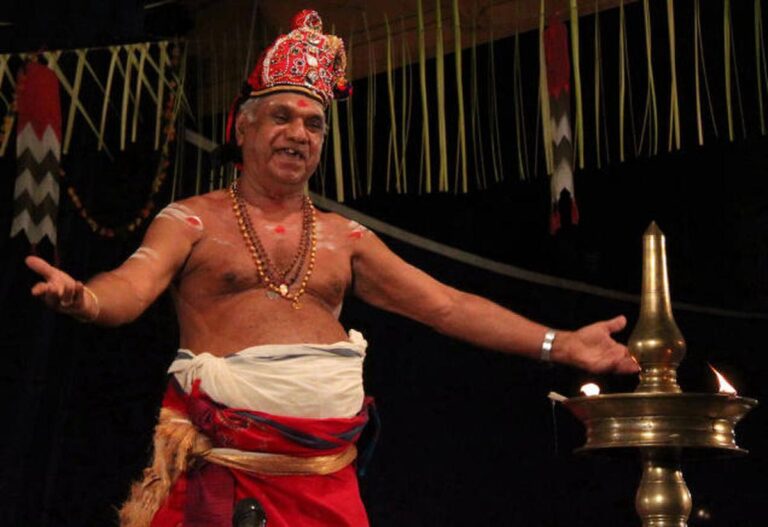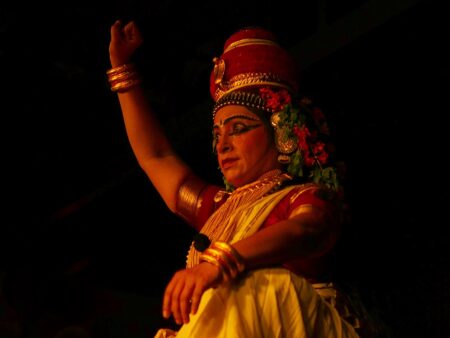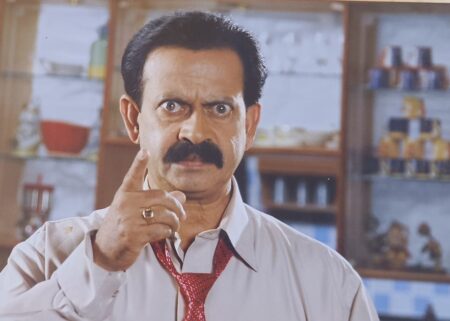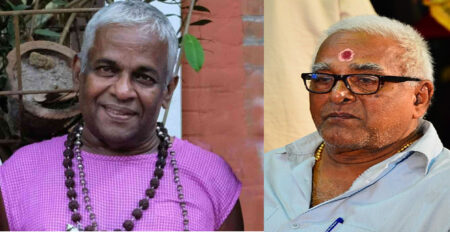A farewell to the maestro of Mizhavu, P K Narayanan Nambiar, whose legacy transcends Koodiyattam.
P. K. Narayanan Nambiar, a luminary in the relam of Koodiyattam and a virtuoso of the mizhavu, passed away yesterday at the age of 96, marking the end of an era. His departure leaves behind a profound legacy that has significantly shaped classical Indian performing arts.
The mizhavu, traditionally shrouded in obscurity even for Koodiyattam aficionados, found a new prominence through Nambiar’s extraordinary skill. Positioned discreetly behind actors on the dimly lit stage in the Koothampalam, the mizhavu’s captivating staccato beats, seemingly breathing life into the performers, had captivated audiences for centuries. Nambiar’s dedication to Koodiyattam and unparalleled contributions propelled the mizhavu to the forefront of classical percussion instruments.
Hailing from a distinguished lineage as the eldest son of the late doyen Mani Madhava Chakyar, Nambiar enjoyed the rare privilege of immersing himself in all aspects of Sanskrit theatre from a young age. Standing out among his contemporaries, his proficiency in Sanskrit, Hindi, and English, combined with rigorous training under his father and esteemed gurus like Kochampilli Raman Nambiar and Meledath Govindan Nambiar, catapulted him to the center stage of Koodiyattam.
In the heyday of Koodiyattam under royal and temple patronage, mizhavu-playing lacked a systematic approach. Nambiar, dissatisfied with the lack of coordination among performers, delved into the art’s intricacies, obtaining rare access to grandhas, a privilege that proved invaluable. Guided by his father and luminaries like Painkulam Rama Chakyar, Nambiar devised a structured training regimen for mizhavu, a model now followed in institutions, including Kerala Kalamandalam, where he served as a teacher from 1966 to 1988. This was imperative in Kalamandalam especially because a strict and systematic format was being followed in all other departments.
A rare artist
Interestingly, Nambiar belonged to that rare genre of artistes who could combine scholasticism with virtuosity in performance. His literary works, Mantrankam based on the third Act of Bhasa’s Prathigyayougandharayanara and Sreekrishna Charitam Nangiarammakoothu that entails the nirvahanam of the “cheti” in the second Act of Subbadrahanajayam have been acclaimed as epoch-making documentation for posterity.
Performances of Mantrankam are near-extinct today for the dearth of artistes who could comprehend the peculiar style of its presentation of varied characters whose verses are noted for their vachyartha (denoted sense), vyangyartha (connoted sense), sleshartha (word play) etc. All these and various stories from Ramayana, Rakshasolpathy, Panchali Swayamvaram and Kiratam have been elaborately dealt with in this precious book.
Nambiar himself exuded an air of fulfillment in that the book on Mantrankam has benefited a group of upcoming artistes in Margi at Thiruvananthapuram. While the book was published by the Kerala Sangeetha Nataka Akademi, Kalamandalam had brought out Nangiarkooth in print that had considerably helped lo revive this once-extinct art form.
Beyond tradition
An illuminating trait of his personality was his ability to accept criticism in spite of being a traditionalist to the core. While welcoming some aspects of Natankusha, a critique of Koodiyattam by an anonymous author of the 15th century, Nambiar hastened to add that many of the author’s observations arose from a lack of knowledge about the framework of Koodiyattam performance. Moreover, one has to realise that staging of Koodiyattam is not strictly in accordance with the tenets of Natyasastra. The various kririyas that have attracted flak from the author are irrelevant for koodiyattom which is “Chakshussa yajna”. One cannot underplay the importance of such ritualistic performances in a Yajna.
Narayanan Nambiar,who was awarded Padma Shri in 2008, was sore that the pristine purity of Koodiyattam has been considerably affected nowadays, especially in some institutions of training. In this connection he deplored the all pervading influence of Kathakali on all performing arts of Kerala. During the old days, the dictum was that a Chakyar shall never chance to see a Kathakali performance. But today we have many institutions where the two art forms are trained under the same roof.
In his passing, Narayanan Nambiar leaves behind a void in the world of Koodiyattam, but his contributions and teachings continue to resonate, ensuring that the legacy of this maestro endures.




